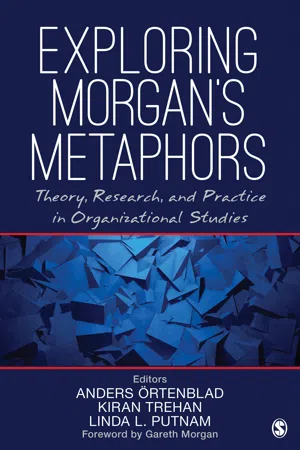
Exploring Morgan’s Metaphors
Theory, Research, and Practice in Organizational Studies
- 304 pages
- English
- ePUB (mobile friendly)
- Available on iOS & Android
Exploring Morgan’s Metaphors
Theory, Research, and Practice in Organizational Studies
About this book
Gareth Morgan's monumental book, Images of Organization, revolutionized the field of organization theory. In honor of Morgan's classic text, this edited volume, Exploring Morgan's Metaphors: Theory, Research, and Practice in Organizational Studies, illustrates how Morgan's eight metaphors inform research, practice, and organizational intervention in a variety of contexts. Including contributions from well-known experts in their fields, specifically, Joep Cornelisen, Cliff Oswick, David Grant, Hari Tsoukas, and Gareth Morgan, this new text offers fresh perspectives and sets forth new metaphors for conceptualizing organizations in today's workforce. Readers will gain insights and guidelines into the different ways that Morgan's metaphors and metaphorical thinking can be used to better understand organizational life, as well as how to study and develop organizations.
Frequently asked questions
- Essential is ideal for learners and professionals who enjoy exploring a wide range of subjects. Access the Essential Library with 800,000+ trusted titles and best-sellers across business, personal growth, and the humanities. Includes unlimited reading time and Standard Read Aloud voice.
- Complete: Perfect for advanced learners and researchers needing full, unrestricted access. Unlock 1.4M+ books across hundreds of subjects, including academic and specialized titles. The Complete Plan also includes advanced features like Premium Read Aloud and Research Assistant.
Please note we cannot support devices running on iOS 13 and Android 7 or earlier. Learn more about using the app.
Information
PART I Making Sense of Images of Organization
1 Introduction From Theory to Application of Metaphor in Organizational Analysis
Overview of Morgan’s Images of Organization
- The machine metaphor highlights efficient production through focusing on inputs and outputs, organizational design, and routinized procedures. It covers organizational theories such as classical management, bureaucracy, and scientific management.
- The organism metaphor casts an organization as a living system by focusing on life cycles, species, ecology, birth and death, adaptation, and survival. It encompasses open systems theory, contingency theories, population ecology, and evolutionary theories of organizations.
- The brain metaphor centers on the learning capacities of organizations by emphasizing information processing, cognitive functioning, right and left brain functioning, memory, and holographic images. It embraces cybernetics, learning theories, and information theory.
- The culture metaphor underscores values, beliefs, symbols, norms, and shared meanings and treats organizations as accomplishments that are socially constructed.
- The political systems metaphor aligns organizations with governance systems, interest-based needs, conflicts, gender and race, and power. This metaphor draws on stakeholder theories, control theories, resource dependency, uncertainty, and boundary management perspectives.
- The psychic prisons metaphor highlights the unconscious, psychological states, anxiety, and defense mechanisms. It embraces psychodynamic views of organizing, Freudian theory, paradoxes and traps, and patriarchy.
- The flux and transformation metaphor accents process, flows, logics of change, circular patterns, and self-production. It includes chaos and complexity theories, mutual causality, feedback loops, and dialectical theories.
- The instrument of domination metaphor highlights exploitation, alienation, class systems, and organizational control, and it draws from Marxist and critical theories.
Uses and Critiques of Images of Organization
Table of contents
- Cover
- Half Title
- Publisher Note
- Title Page
- Copyright Page
- Brief Table of Contents
- Detailed Contents
- Foreword
- Preface
- About the Editors
- About the Contributors
- PART I Making Sense of Images of Organization
- 1 Introduction From Theory to Application of Metaphor in Organizational Analysis
- 2 Reflections on Images of Organization
- 3 Morgan’s Legacy in Theorizing and Understanding Organizations
- PART II Using Metaphors in Organizational Analysis
- 4 Approaches to Using Metaphors in organizational analysis Morgan’s Metaphors and Beyond
- 5 Viewing Organizations as Enablers of Happiness
- 6 Combining Metaphors to Understand New Organizational Phenomena
- 7 Exploring Metaphors of Leadership
- 8 Developing Metaphors in Light of the Visual and Digital Turns in Organizational Studies Toward a Methodological Framework
- Part III Reflections, Commentaries, and Constructive Critique
- 9 Imagination and the Political Use of Images
- 10 Organization as Affect Moving on Metaphorically
- 11 The “Metaphor” Metaphor Educating Practitioners for Reflective Judgment
- 12 Of Tropes, Totems, and Taboos Reflections on Morgan’s Images From a Cross-Cultural Perspective
- Glossary1
- Index